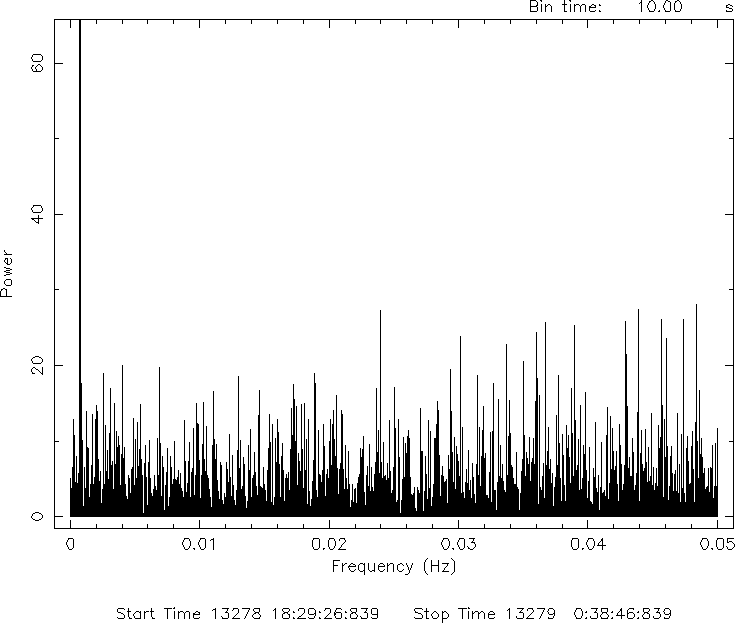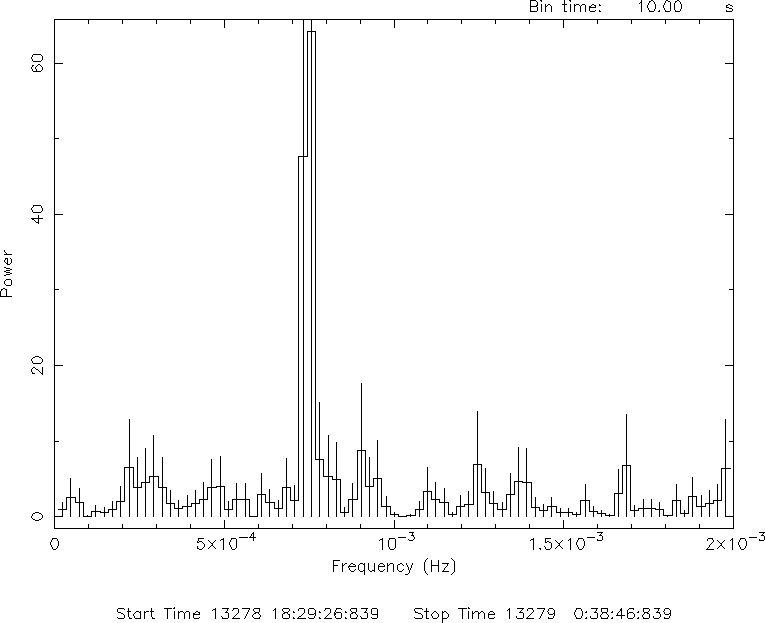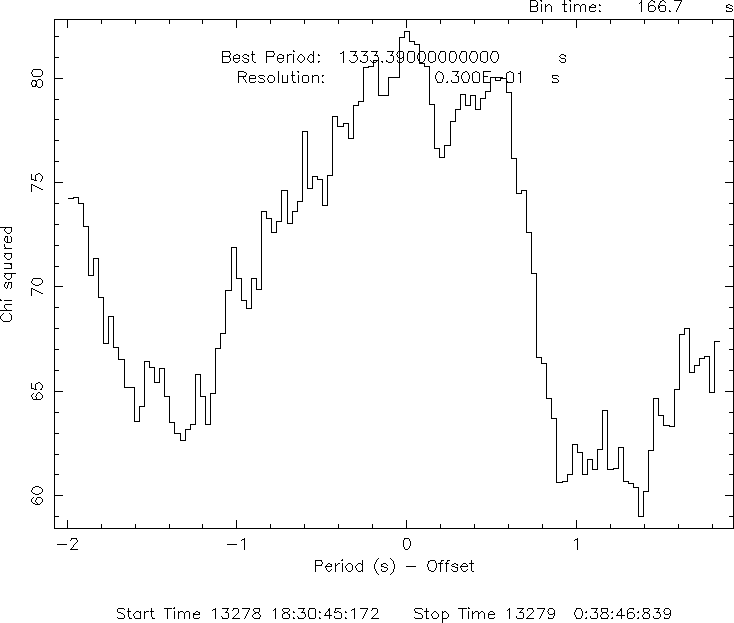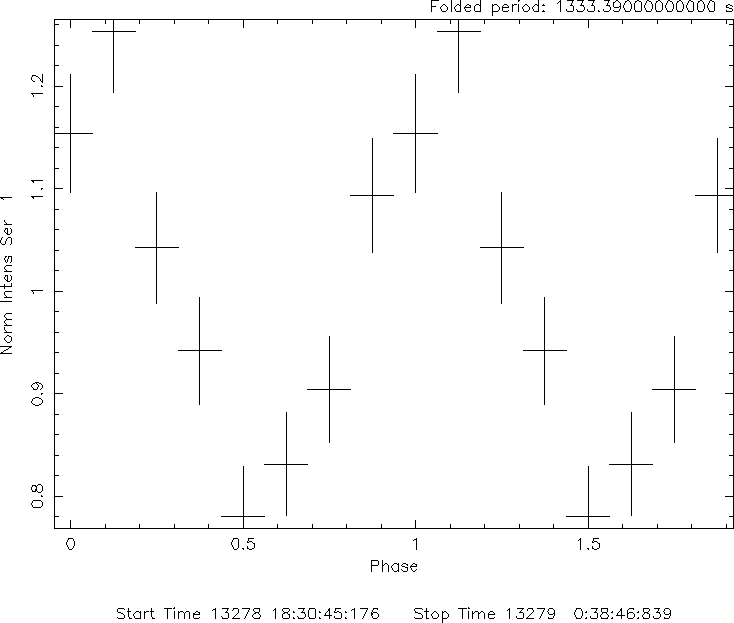SAS Thread - timing-mk-linux - XMM-Newton
Timing Analysis with XMM-Newton EPIC / RGS data
|
Introduction The purpose of this thread is to give some guidelines on getting started with further analyses of XMM-Newton X-ray light curves. As a most common example, period searches and the creation of phase-folded light curves is described. Expected Outcome Power spectrum plot and folded light curve. Tasks to be Used
Prerequisites
Useful Links
Last Reviewed: 31 Januray 2025, for SAS v22.0Last Updated: 29 October 2014 |
Content
1. Preparation
2. Find the period of the object with the powspec tool
3. Find the exact period of the object with the efsearch tool
4. Produce the folded light curve of the object with the efold tool
Preparation
This thread is based on having already produced a light curve. The Extraction and correction of an X-ray light curve for a point-like source thread gives instructions. Note that the time binning has to be smaller than the period that is to be measured. In this thread an example light curve source.lc is provided that has been extracted from ObsID 0204690101 (V4743 Sgr; see Dobrotka and Ness 2010) using a time binning of 10 seconds.
The SAS contains no timing analysis tool, but XRONOS, as part of the FTOOLS software package, can be used with XMM-Newton data. FTOOLS are used from the command line. Whenever a parameter needs to be provided, the user will be prompted to type in something. A default value is suggested in square brackets that can be accepted by hitting enter. The suggested default values are taken from a parameter file that can be found in the directory $HOME/pfiles/, for example, $HOME/pfiles/powspec.par for the parameters of powspec (see below). In order to reset the parameters, the task needs to be unlearned with punlearn. In this case the command line would be:
punlearn powspec
Procedure
1. Find the period of the object with the powspec tool
The powspec tool calculates a power spectrum, which gives a likelihood for the existence of a range of frequencies on a frequency grid. It is called from the command line:
powspec
The parameters can be provided in two ways:
- With the call above they will be queried interactively
- Provide parameters on the command line. Explanations can be found in Sect. 5.9 of the XRONOS manual.
If no parameters are provided on the command line, the following prompts occur for the example light curve:
- Ser. 1 filename +options (or @file of filenames +options)[file1]
The name of the fits file containing the light curve needs to be provided, in the example case source.lc
If multiple light curves are to be analysed, a list of files can be written into an ASCII file, following the description in Sect. 4.2. of the XRONOS manual. The name of this file is communicated to powspec with @file.
Information available from the header will be displayed.
- Name of the window file ('-' for default window)[-]
For default window, hit enter, or type -
For other options see Sect.9.4 of the XRONOS manual.
Binning information will be displayed:
**** Warning: Newbin Time must be an integer multiple of Minimum Newbin Time
Minimum Newbin Time 10.000000 (s)
for Maximum Newbin No.. 2217
- Newbin Time or negative rebinning[4.6692607009327]
A binning has to be given that is smaller than the period of the object.
As noted in the previous message, an integer multiple of the Minimum Newbin Time has to be given. In this example, a multiple of 10 has to be entered.
In this example, 10 has been entered, the new number of maximum bins will be calculated, and the following messages appear:
Newbin Time ...... 10.000000 (s)
Maximum Newbin No. 2217
Default Newbins per Interval are: 4096
(giving 1 Interval of 4096 Newbins)
Type INDEF to accept the default value
- Number of Newbins/Interval[10]
The default value will create many plots at a later stage, and it is better to type in the maximum Newbin No. given above.
Thus, for the example case, type 2217
- Number of Intervals/Frame[1]
1
- Rebin results? (>1 const rebin, <-1 geom. rebin, 0 none)[0]
0
- Name of output file[default]
(enter)
- Do you want to plot your results?[yes]
(enter)
- Enter PGPLOT device[/XW]
(enter)
and WAIT until power spectrum appears.
To zoom in to the highest peak use
r x 0 2e-3
to find the global maximum of the power distribution. For the given example, a value of 7.5x10-4 Hz (1333.3 sec period) is found as a start value for further analysis (below).
Leave the interactive plot environment by typing
exit
or
q
 |
 |
Fig.1: The total view (left) and a zoom into the peak (left) of the powerspectrum, produced with the above commands, can be seen (click to enlarge).
2. Find the exact period of the object with the efsearch tool
The following lines are a small csh script, that executes the period search via folding versus homogeneity. The commands can also be typed in the command line. The script may be more useful to run multiple times with different settings and later with a higher accuracy.
####################### script p_search.csh ####################
#!/bin/csh -f
efsearch cfile1="source.lc" \
window='-' \
sepoch=INDEF\
dper=1333.33\
nper=128 \
nphase= -3 \
nbint=8297 \
dres=0.03 \
plot=yes plotdev="/ps" outfile="p_search" \
plotfile="p_search.pco"
#########################################################
Explanations of the parameters can be found in Sect. 5.4 of the XRONOS manual.
A ps file pgplot.ps is produced. Since this will be overwritten with the next plot command, a copy should be made, e.g.,
cp pgplot.ps period.ps

Fig.2: The plot produced with the above script (click to enlarge). The best-fit period is given in the plot as 1333.39 seconds.
3. Produce the folded light curve of the object with the efold tool
######################### script fold.csh ######################
#!/bin/csh -f
efold \
nser=1 \
cfile1="source.lc" \
window='-' \
sepoch=0.00000\
dper=1333.39\
nphase=-3 \
nbint=133\
nintfm=1 \
plot=yes plotdev="/ps" outfile="fold" \
plotfile="fold.pco"
#########################################################
Explanations of keywords can be found in Sect. 5.4 of the XRONOS manual.
A ps file pgplot.ps is produced. Since this will be overwritten with the next plot command, a copy should be made, e.g.,
cp pgplot.ps fold.ps
|
Caveats |
- Removed a total of (1) style text-align:center;
- Removed a total of (5) style text-align:justify;
- Removed a total of (2) style float:left;
- Removed a total of (1) align=center.
- Removed a total of (3) border attribute.
- Converted a total of (5) center to div.








































 Sign in
Sign in
 Science & Technology
Science & Technology
